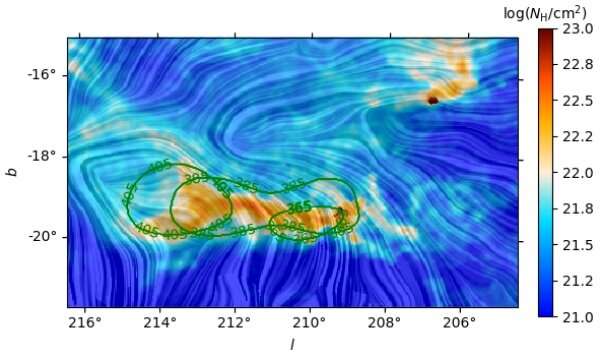July 13, 2020 report
Structure of the molecular cloud Orion A investigated in detail

Using a 3-D mapping technique, astronomers from Sweden and Germany have explored a nearby molecular cloud known as Orion A. The new study unveils more details about the structure and nature of this cloud. The research was presented in a paper published July 6 on the arXiv pre-print repository.
Located between 1,000 and 1,400 light years away, the Orion Molecular Cloud Complex (Orion Complex for short) is a star-forming region spanning hundreds of light years across. It is one of the most active regions of nearby stellar formation visible in the night sky and consists of two giant molecular clouds designated Orion A and Orion B.
About 3,000 young stellar objects formed in Orion A in the last few million years, which makes it the most active star-forming region in the local neighborhood. However, although this molecular cloud has been extensively studied in the past, its complex structure is not yet fully understood.
One of the methods that could help in investigating the structure of molecular clouds is mapping their full three-dimensional dust distribution. Knowing the 3-D distribution of the dust toward the Orion Complex can provide valuable information about the distance and structure of its clouds. So a team of astronomers led by Sara Rezaeikhoshbakht of the Chalmers University of Technology in Gothenburg, Sweden, used this technique in order to explore the structure of Orion A.
"In the present work, we improve our mapping technique by including both distance and extinction uncertainties, together with resolving the computational limitations, thereby allowing us to exploit a large dataset like Gaia DR2 as the input, and to produce a detailed 3-D dust map of the Orion A," the researchers wrote in the paper.
The team analyzed the dataset from ESA's Gaia satellite (Data Release 2, DR2) to get the 3-D positions of stars. The study was completed by data from NASA's WISE spacecraft and from the Two Micron All-Sky Survey (2MASS).
The method allowed the astronomers to illustrate the whole shape of Orion A with its extended tail to distances of about 1,600 light years. The results suggest that the length of the cloud exceeds 300 light years.
The study reports, for the first time, a bubble-like dust overdensity at approximately 1,150 light years from the Earth in front of the Orion A cloud. In addition, a background component to the Orion B cloud was identified at a distance of around 1,500 light years.
Furthermore, the astronomers found the presence of stellar associations older than that of the Orion Nebula Cluster (ONC), a very young (less than 1 million years old) cluster in Orion A. These associations were identified around the same location as the detected foreground dust overdensity, and the researchers assume that it indicates an early star formation episode in front of the ONC.
"This could have triggered subsequent episodes of star formation in the region," the scientists explained.
More information: Detailed 3-D structure of OrionA in dust with Gaia DR2, arXiv:2007.01331 [astro-ph.GA] arxiv.org/abs/2007.01331
© 2020 Science X Network




















